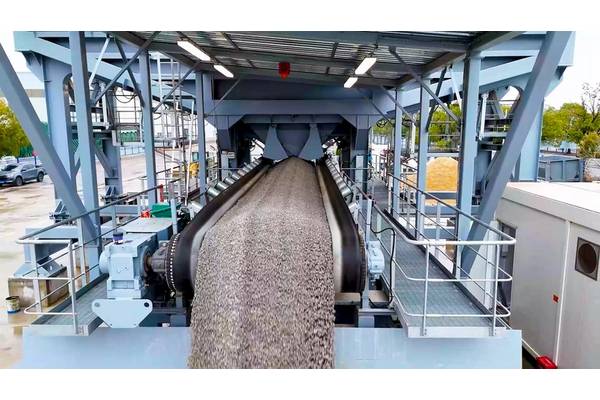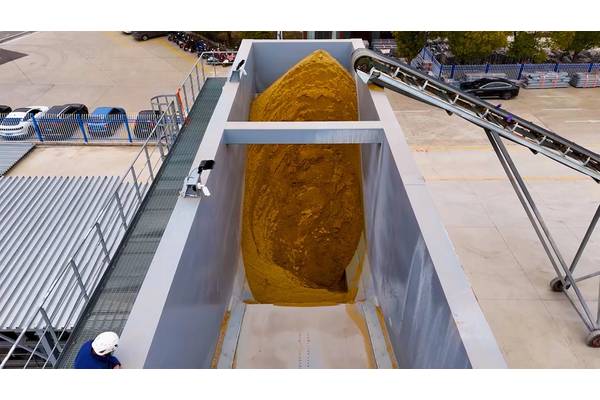



Following extensive studies to verify GravityVibe’s feasibility, MacGregor is now engaged in the real-world validation and optimization of its self-unloading system based on in-house testing and customer feedback.
Evidence that verifies the advantages of GravityVibe has been accumulating since MacGregor introduced the augmented gravity self-unloading system to market in February 2024.
Developed to allow bulk carriers to deliver a wider variety of cargo in greater volume, GravityVibe eases the discharge of coarse materials from cargo holds. In contrast with a standard gravity self-unloading configuration, where slope angles range from 35 to 60 degrees depending on the material, MacGregor’s system can discharge various cargo types with slope angles of just 15–20 degrees.
MacGregor collaborated with various international institutions and organizations to verify GravityVibe’s feasibility in theoretical studies. In a simulation based on a theoretical model of the system, TUNRA – a wholly owned subsidiary of the University of Newcastle, Australia – found that GravityVibe functioned effectively with the three materials tested: wood chip, manufacturing sand, and gravel.
MacGregor later sought to ascertain the impact of the system’s vibrations and how to minimize their transfer into the vessel’s hull structure. The company worked with leading international sub-suppliers, and separately with the KTH Royal Institute of Technology in Sweden, to conduct thorough vibration and sound analyses. In both studies, vibration and sound readings were comfortably within the class-defined threshold.
MacGregor is now engaged in efforts to validate the system’s performance in practical analyzes using a full-scale test rig in China. Already, the company has confirmed the findings of TUNRA, its sub-suppliers, and KTH: GravityVibe efficiently discharges wood chip, manufacturing sand, and gravel, while both vibration and sound levels fall far below the upper limits stipulated by class.
Building on these results, MacGregor continues to validate GravityVibe’s performance in real-world tests. According to Mikael Hägglund, Sales Manager for General Cargo, the company has turned its attention to optimizing the system based on data gathered from the test facility.
 “All the materials we have tested have flowed without any issues, so we know GravityVibe works, which is the first and most important step,” said Mikael Hägglund, Sales Manager for General Cargo, MacGregor. “As our approach to R&D emphasizes continuous improvement, we are now working to finetune the system’s performance by adjusting its parameters for even more efficient and reliable cargo discharge.”
“All the materials we have tested have flowed without any issues, so we know GravityVibe works, which is the first and most important step,” said Mikael Hägglund, Sales Manager for General Cargo, MacGregor. “As our approach to R&D emphasizes continuous improvement, we are now working to finetune the system’s performance by adjusting its parameters for even more efficient and reliable cargo discharge.”
While theoretical studies and extensive in-house testing are crucial aspects of MacGregor’s R&D process, the company also places great importance on customer demonstrations and feedback.“By discussing GravityVibe with our customers, showing them its functionality and inviting their input, we gain a deeper understanding of what matters most to their operations,” said Tomas Wallin, Senior Product Owner, MacGregor. “Customer consultation plays an invaluable role in a product’s validation and optimisation while nurturing confidence among our target audience. It therefore helps us to prepare our systems for a successful market launch.”
Involving customers in the testing phase also enables MacGregor to establish parameters for the programmable logic controller and software on board the vessel, ensuring that GravityVibe executes the complete unloading process as smoothly and intelligently as possible. Ultimately, MacGregor’s objective is to enable the fully automated discharge of all kinds of bulk cargo.
Critical to this aim is GravityVibe’s self-optimization functionality. Extracting data from built-in sensors, the system ‘learns’ the characteristics of each material and adjusts its vibration frequency accordingly, achieving optimal flow regardless of the cargo being unloaded and without the need for human intervention. As a result, the operator avoids overworking the system, which in turn minimizes energy consumption as well as operating and maintenance costs.
In the coming months, MacGregor aims to validate GravityVibe’s performance with a wider range of materials to identify any operational limitations, making technical adjustments and functional improvements as needed ahead of the system’s market launch.



